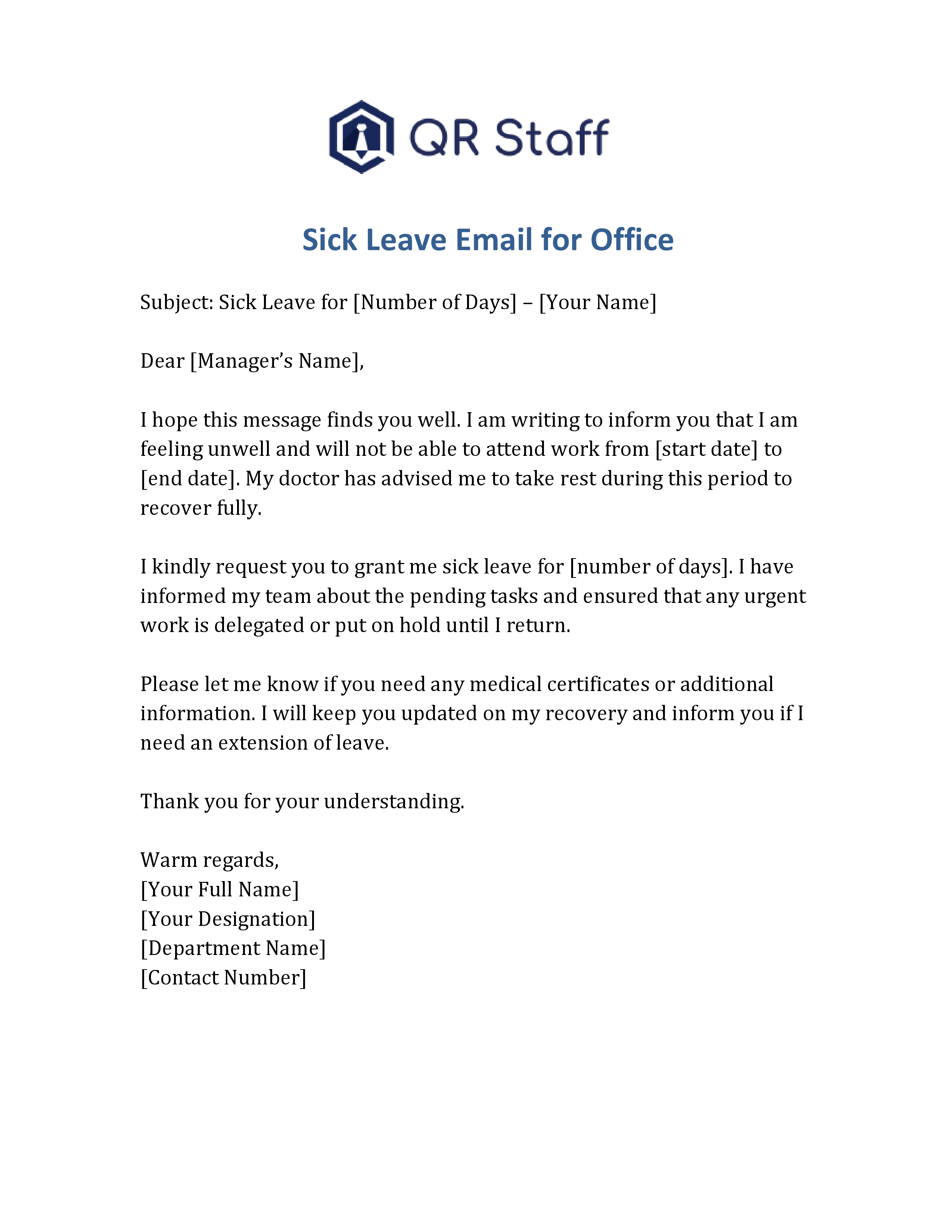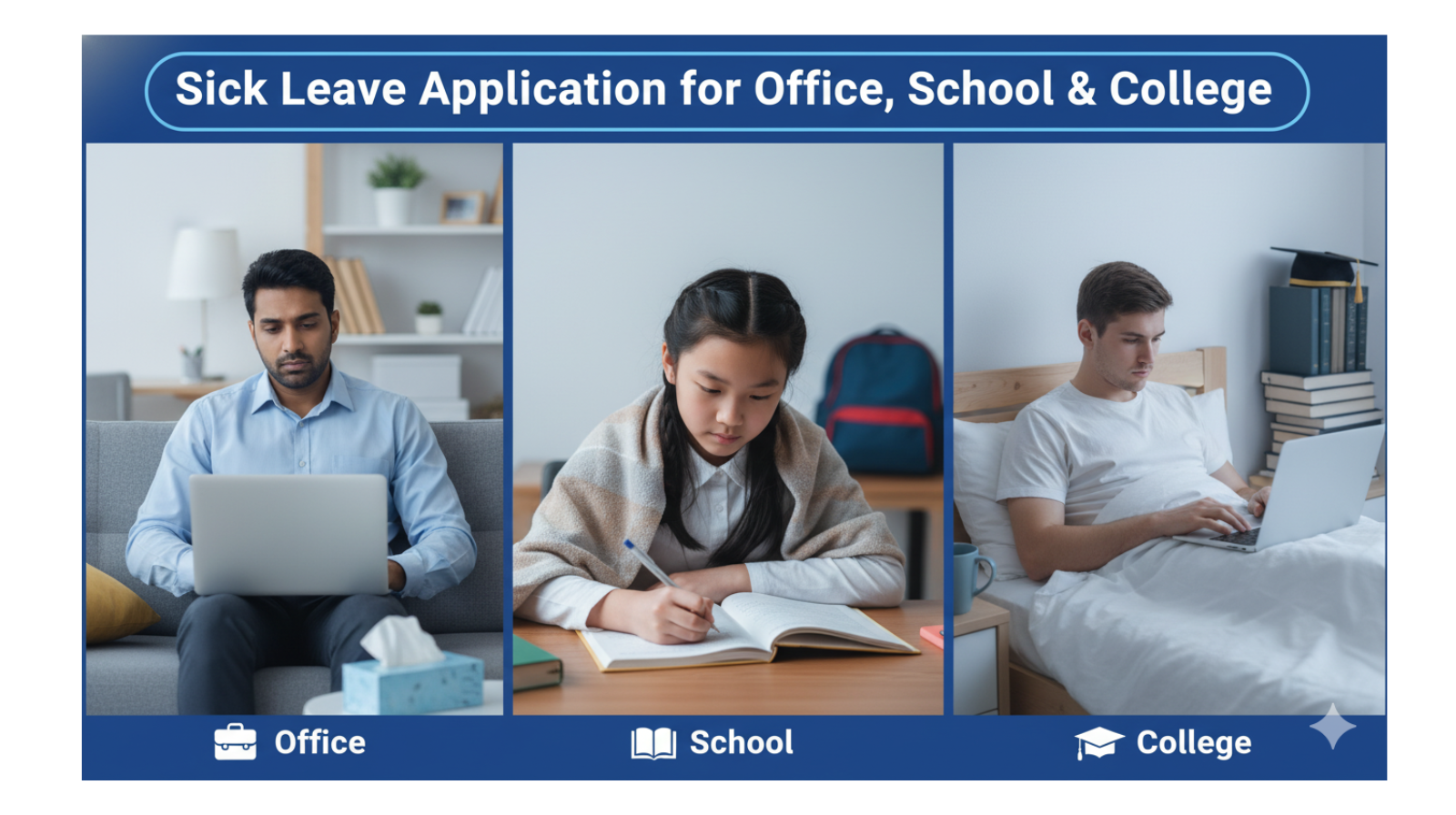A sick leave application is a formal request you send to your employer, principal, or teacher to let them know you’re feeling unwell and can’t attend work or classes. It’s a professional way to communicate your absence and seek approval for some time off due to health issues. Writing a proper sick leave letter is important because it promotes transparency and helps your employer or institution manage its tasks while you’re away. No matter if you’re an employee, student, or teacher, a well-crafted sick leave application shows that you’re responsible and professional. In both educational and professional settings, it’s essential to keep everything running smoothly. That’s why submitting your leave request promptly is key—it helps avoid any disruptions and keeps attendance records in check. In this detailed guide, we’ll go over how to write a sick leave application, explore the various types of sick leaves, and provide sample applications for offices, schools, and colleges, along with free downloads in Word and PDF formats.
Why Writing a Proper Sick Leave Application Matters
A properly written sick leave application is crucial for effective communication with your boss, principal and teacher. It helps management keep track of attendance and organize workflow accordingly. Without a formal notice, your absence could lead to misunderstandings or work delays. By submitting an application, you show accountability and discipline—qualities that are important in both academic and corporate settings. In addition, a professional sick leave request helps maintain an official record of your absence for payroll and attendance purposes. This ensures that your salary and performance records aren’t negatively impacted. For students, it also reflects a genuine commitment to their studies and respect for school policies. Finally, in our modern digital landscape, where attendance systems and HR tools like QR Staff handle everything automatically, sending a leave application is a great way to enhance these digital processes.
Types of Sick Leave
Understanding the various types of sick leave can guide you in selecting the appropriate words and tone for your application. Each type is designed for a specific purpose and time period, so it’s worth knowing the differences.
1. Casual Sick Leave
Casual sick leaves are usually availed for minor ailments such as cold, fever, or headache. Approval is usually granted for one or two days and does not involve lengthy procedures of providing doctor-patient certificates. This type of leave is availed when one needs a little rest and can resume duties the very next day. A gentle message quoting the sickness and days taken is enough. It is always better if you can inform your employer or teacher in advance once you are aware of your inability to attend classes or go to work.
2. Short-Term Medical Leave
Short-term medical leave applies when your illness extends beyond two or three days but is not chronic. It may be due to viral infections, mild injuries, or recovery after medical procedures. You should, in this case, specify the exact number of days you’ll be absent and attach a medical certificate if possible. This kind of leave shows that you take health seriously and respect official processes. Submitting your application early also helps your supervisor plan workloads efficiently.
3. Long-Term Medical Leave
Long-term medical leave is used for severe health issues or surgeries that need extended recovery. It could be anywhere from a few weeks to months. To this, you may want to attach a detailed letter explaining your condition, attach medical documentation if necessary, and state an approximate return date. This will also enable the HR or school administration to manage responsibilities or coursework accordingly. Clear communication during long-term absence ensures understanding and minimizes disruption.
4. Half-Day Sick Leave
Half-day sick leave is requested when one is feeling unwell and can attend only part of the day. This is suitable for everything ranging from medical appointments to minor fatigue. You can be specific by specifying whether your leave is for the first or second half of the day. In this case, only a short message about your situation and expected time of return should suffice. This shows concern for your organization’s time and keeps the workflow going without a jolt.
5. Emergency Medical Leave
Emergency medical leaves are taken all of a sudden for unforeseen illness or accidents. As such situations take place without giving prior notice, it is better to at first inform the supervisor or teacher through a quick call or message and then with a written application. Emergency leaves show your integrity and immediate communication in case of an unplanned health situation. Mentioning your current condition and expected recovery time helps the concerned authority understand your situation better.
Step-by-Step Guide: How to Write a Sick Leave Application
Writing a sick leave application requires clarity, respect, and precision. Here’s a simple guide that applies to employees, students, and professionals.
1. Write a Clear Subject Line
A distinct subject line makes your email or letter catch the attention of a person right in the very instant. This subject should summarize your purpose in a few words. Use phrases like “Sick Leave for Two Days” or “Medical Leave Due to Fever.” Avoid subjects like “Leave Request.” The specific subject line makes it clear to the reader as to the urgency and type of leave requested, thus saving time and improving communication.
2. Address the Right Person
Your application should always be addressed to the proper authority, such as your manager, HR, class teacher, or principal. You may use polite salutations like “Dear Sir/Ma’am” or “Respected Principal.” Sending the application to the wrong person may create confusion or delay the approval process. This also portrays professionalism and respect to the recipient.
3. Mention the Reason for Leave
Clearly mention the reason for which you need leave and the duration you expect to be away. There is no need for unnecessary explanation; just a short and honest reason would do. Example: “I am suffering from viral fever, and the doctor has advised rest for three days.” In this way, it will be easy for your employer or teacher to understand your problem and sanction your leave immediately.
4. Specify Duration Clearly
Always include the dates of your starting and last day of sick leave. This enables the office or school to manage and handle your case effectively. If you’re unsure about the period of recovery, say so; you will send an update once your health improves. Clear communication of duration helps in planning substitutes or temporary adjustments during your absence.
5. Provide Work or Study Handover, if applicable
If you’re an employee, you would include here that you have forwarded important tasks to a colleague or have given the necessary instructions; for students, you can include that you will make up for missed work or assignments when you get back. This would show responsibility and would ensure them that your absence wouldn’t affect the general workflow or the process of academic activity.
6. Thank the Reader and Close Politely
Always close your application with a thankful note, like “Thank you for your understanding” or “I appreciate your consideration.” Close your application respectfully using “Sincerely” or “Yours faithfully,” adding your full name, designation, class, or contact information. This polite ending leaves a positive impression and reflects your professionalism.
Sick Leave Application Format For Office
When writing a sick leave application for office, keep your tone formal, concise, and respectful. Mention your illness, leave duration, and assure your manager of a smooth workflow in your absence.

Sick Leave Email Format For Office

Sick Leave Application Format For School
A school sick leave application is usually written by parents or students in a simple and polite tone. It should include the reason for leave and the duration clearly.

Sick Leave Application For College
College sick leave applications are more formal as they are addressed to professors, department heads, or principals. It’s important to mention course details and ensure a respectful tone.

Different Types of Leave Application Format
| Formats | Files |
|---|---|
| Leave Application Format in Word | Download Word File |
| Leave Application Format in PDF | Download PDF File |
Common Mistakes to Avoid While Writing a Sick Leave Application
It’s important to avoid a few common mistakes when submitting your leave request.
- Not mentioning clear leave dates or duration.
- Using informal or casual language in professional contexts.
- Forgetting to include a subject line or greeting.
- Not signing the application with your name or details.
- Application submitted after the deadline without prior notification.
Benefits of Using a Digital Leave Management System
The process of maintaining sick leaves is quite confusing and time-consuming if done manually. A digital attendance and leave system, such as QR Staff, makes the process much easier to handle, both for employees and for HR managers. It automates leave tracking, approval workflows, and record maintenance. Employees can easily apply for leave through their phones, and managers can approve or reject requests instantly.
This reduces the paperwork, saves time, and also provides transparency to both sides. In schools or colleges, such systems allow better management of attendance and reduce human errors. The whole process goes smoothly, accurately, and professionally.
How can I write a proper Leave of Absence Application for office, school, or college?
Writing a Leave of Absence Application becomes easy when you follow the right format and tone. You just need to mention the reason for your leave, duration, and request for approval in a polite manner. you can check our detailed guide —
Application for Leave of Absence – Office, School & College — where we’ve shared professional samples, structure, and downloadable Word templates for every category.
Conclusion
Writing a formal application for sick leave shows professionalism and serves as an official record for your absence. As an employee, student, or teacher, a respectful and structurally well-formed request for leave speaks volumes about being responsible and disciplined. Always mention the cause, period of leave, and contact information and end graciously.
Make attendance and leave management a breeze with QR Staff, modern attendance management software that automates leave tracking and attendance monitoring for payroll processing. QR Staff supports companies, schools, and institutions in managing records of their staff with just a few taps. It’s time to get rid of paperwork and switch to smart, fast, and digital attendance solutions offered by QR Staff.
Frequently Asked Questions (FAQs)
1. How do I write a sick leave application for office?
To write a sick leave application for office, mention the recipient’s details, date, subject line, and a short description of your illness. Include the number of days you’ll be absent, express gratitude, and sign with your name and contact details. Always keep your tone polite and professional.
2. What is a sick leave application?
A sick leave application is a formal letter or email written to inform your employer, teacher, or principal about your illness and request permission to stay absent for a specific period. It helps maintain transparency and ensures your absence is officially recorded.
3. What should I include in a school sick leave application?
A school sick leave application should include the student’s name, class, roll number, reason for absence, and leave duration. It should be addressed to the class teacher or principal and written in a simple and respectful tone.
4. Can I send a sick leave application through email?
Yes, you can send a sick leave application through email. Just make sure to use a clear subject line, polite language, and proper formatting. Mention your contact number for follow-up if necessary.

Leave a Reply